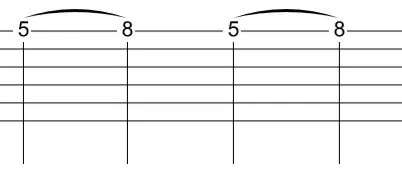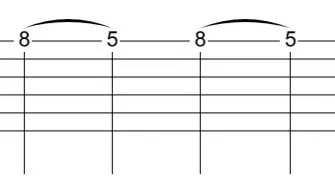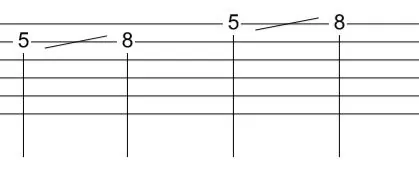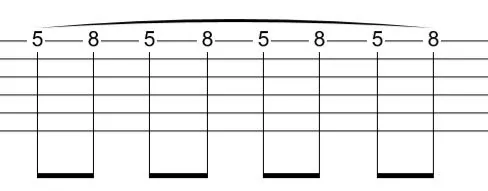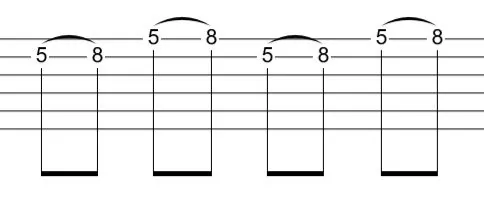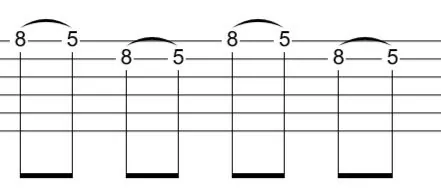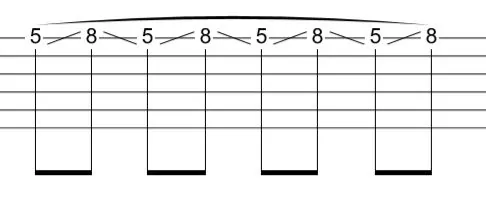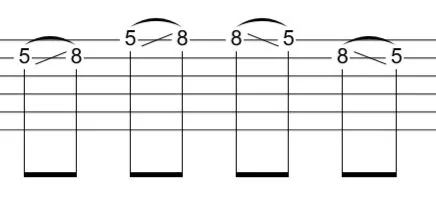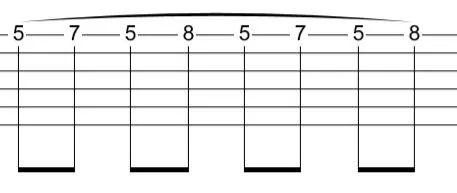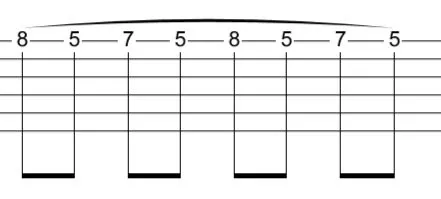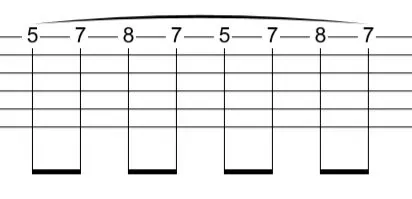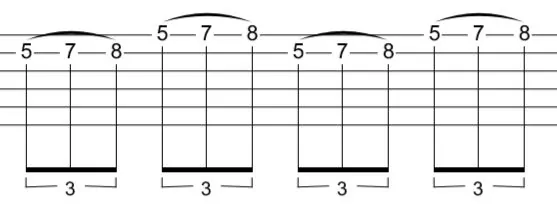Legato is a term that guitar players should be familiar with. The word Legato comes from the Italian term meaning “tied together”, when applied to the guitar, this means we are taking notes and literally tying them together with various techniques that fit into the family of legato.
Legato is a great way to increase the number of notes you are playing but without needing to pick every single note. Many shred guitar heroes such as Richie Kotzen and Joe Satriani swear by legato to get their fretboards blazing with notes.
The three techniques we will be looking at in this lesson as part of our legato workout are hammer ons, pull offs and slides. Each of these techniques is a way to join notes up without re-picking the string. As the lesson goes on we will look at combining these techniques in longer phrases.
This lesson will work on your fretting hand strength and coordination but be sure to warm up full before attempting some of the more advanced legato exercises as they can be quite intensive on the fretting hand muscles.
Contents
Exercise 1
Guitar Tab showing a pair of hammer ons on the E string using the A Minor Pentatonic Scale.
Legato is all about rhythm and keeping things consistent. Let’s start with a small warm-up doing some hammer-ons as quarter notes between the 5th and 8th fret of the E string. The initial picked note should happen on the first beat, with the little finger hammering onto the 8th fret on the second beat.
If you are new to hammer-ons, you may need to push yourself to use a little extra force with the little finger to get the second note to sound clear. Don’t worry, this will become less strenuous as you develop some strength in that finger.
When performing hammer-ons, you want the note that you hammer with your little finger to be the same volume (or as close as possible) as the note that you picked. This gives you a consistent volume across both notes.
Exercise 2
Guitar Tab showing a pair of pull-offs on the E string using the A Minor Pentatonic Scale.
The reverse of a hammer-on is a pull off. A pull-off involves putting both fingers in place and pulling the higher note off to the lower one. If you lift your finger straight off the note, you will notice a volume drop.
As with hammer-ons, you want the second note to be of equal volume. To achieve this with pull off, you should aim to give the string a little flick downwards with the finger that is on the higher notes. As it lifts off, this little downward flick will create the same effect as picking the string and give the string enough energy for the second note to ring clear.
Exercise 3
Guitar Tab showing a pair of ascending slides on the B and E strings using the A Minor Pentatonic Scale.
Another member of the legato family is the slide. If you’ve never played a slide before, it involves placing your finger on a note and picking it before sliding to a higher (or lower) note without releasing the pressure. When working with slides the tricky thing is to keep a consistent pressure so that you don’t lose the note as you move, but while not applying too much pressure that the note drags along the fretboard.
This exercise is a simple slide from the 5th fret to the 8th fret on the B string, followed by the E string. You want to keep your fretting hand relaxed as you perform the slide so that the motion across the frets is smooth. If you apply too much pressure, you will hear each fret as you pass over it. You should always aim for your slides to sound smooth and effortless.
Exercise 4
Guitar Tab showing a pair of descending slides on the B and E strings using the A Minor Pentatonic Scale.
This slide based exercise uses the same notes as the previous exercises but works backwards. Typically, when playing through scales you would play the higher notes of each string with your ring or little finger. When playing this exercise you can approach it with your first finger as your sliding finger just to get a feel for the backwards slides, but in a more real world approach you could attempt this with other fingers.
This will simulate how you might handle these types of slides in the middle of a lead guitar passage.
Exercise 5
Guitar Tab showing an eighth note hammer on and pull off pattern starting with a hammer on. The exercises is on the E string using the A Minor Pentatonic Scale
Using the technique of both a hammer on and pull-offs, you can create longer legato passages. This 8 note pattern only involves picking the string once. You would pick the 5th fret on the E string before hammering on to the 8th fret. After the hammer-on, you will pull off to the 5th fret again. This then repeats.
Start slow with this and work on keeping it rhythmic. Think of this exercise as straight eighth notes, the 5th fret sounds on each beat and the 8th fret sound on the “&” between each beat. The pattern is a repeated hammer on and pull off pattern so totally relies on the strength of your fingers to maintain the volume of the note.
As with doing singular hammer-ons, the harder you hammer, the more energy you put back into the string. At first, doing a longer string of this might feel like it’s making you overwork the hand but with safe repetition, the hand will develop strength.
Exercise 6
Guitar Tab showing an eighth note hammer on and pull off pattern starting with a pull off. The exercises is on the E string using the A Minor Pentatonic Scale
This exercise follows the same form as the previous except we now start with a pull-off on the first beat and the lower note appears between each beat. The additional challenge here is keeping the note volume consistent across all the pull-offs.
As with the singular pull-offs, a small flick of the string as you pull off will give it sufficient extra energy to ring a little louder than if you just lift your finger upwards off the string.
Exercise 7
Guitar Tab showing an eighth note hammer on pattern alternating between the B and E strings using the A Minor Pentatonic Scale
We can apply the idea of a singular hammer on and put this across multiple strings to make note only a great exercise for both legato skills and coordination, but it also makes a great addition to any guitar solo.
This exercise is in straight eighth notes with each 5th fret falling on one of the beats. Your first finger will be leading all of the string changes in this exercise so start slow to be sure that you’re getting the required accuracy before trying to speed this up. You want every single pair of notes to fall on the beat and sound crisp.
Exercise 8
Guitar Tab showing an eighth note pull off pattern alternating between the B and E strings using the A Minor Pentatonic Scale
In the same way bursts of ascending hammer ons can sound great in a lead guitar break, descending pull-offs will also sound impressive, especially as that speed develops over time.
This exercise is also straight eighths but this time you will be starting with the pull-off from the 8th to the 5th fret on the E string before shifting to the B string and doing the same. This time, the string change is handled by the finger playing the higher notes, so if you are doing this pull off with your little finger, which I would recommend, this might feel a little slower than it’s hammer-on variation.
It takes some time to build up the speed in the little finger, especially when using it to lead a phrase like this.
Exercise 9
Guitar Tab showing an eighth note slide pattern which ascends and descends in an eighth note rhythm on the E string using the A Minor Pentatonic Scale
This rhythmic sliding exercise will work best with a loud amp with lots of sustain, it might be a bit lost on the clean channel and certainly won’t do any justice on your acoustic guitar but this is a fun one to play with a cranked, overdriven amp.
Like the hammer on and pull off versions, you will be sliding between the 5th and 8th frets having only picked the first note. This type of exercise is prone to losing sustain very quickly so don’t be afraid of making your sliding motions a little more aggressive than usual just to add a bit more energy back into the string as it sustains.
Remember to keep this rhythmic and stick to the beats. It can be a really interesting effect to throw into a lead break.
Exercise 10
Guitar Tab showing an eighth note slide pattern that ascends and descends alternating between the B and E strings using the A Minor Pentatonic Scale
This exercise uses slides in both an ascending and descending groups. The first two beats you will be sliding from the 5th to the 8th frets and on the third and fourth beats you will be sliding back from the 8th to the 5th frets.
This exercise can be a great way to train strength in various fingers. You can approach the finger patterns in this exercise in a variety of ways. The main two being using your first finger for each slide, or using your first singer for the ascending slides and your little finger for the descending slides.
Another interesting way to play this is to repeat the phrase 4 times but complete each repetition with a different finger each time. First finger on the first repeat, middle finger on the second, ring finger on the third and little finger on the fourth.
This will also increase your fretboard accuracy when searching for notes with fingers that you might not instinctively use to target starting notes.
Exercise 11
Guitar Tab showing an eighth note hammer on pattern ascending through the A Minor Pentatonic Scale from Low E to High E string.
This exercise is a hammer on pattern running up the A minor pentatonic scale from the low E to the high E. Each note is a quarter beat long so you will only be picking each string once on the first and third beats with the hammer-ons filling in the gaps on the second and fourth beats.
This will get your hands used to playing legato runs across multiple strings and can be very useful in helping your picking hand branch out into playing across a range of strings too.
As with all hammer ons, you want to aim for the hammered note to achieve the same volume as the initial picked note.
Exercise 12
Guitar Tab showing an eighth note hammer on pattern descending through the A Minor Pentatonic Scale from High E to Low E string.
This exercise is the pull-off equivalent to the previous hammer-on based pattern. This is descending through the A minor pentatonic scale with a series of pull offs. You will be leading this with your little finger playing the pull off from the 8th to the 5th fret but this is a good opportunity to incorporate the ring finger for any strings where you pull off to the 7th fret.
With the pull-offs, aim to keep the energy in the string after the pull off by giving the string that little downward flick that we’ve discussed earlier in this lesson. Remember you are leading the string changes here with a higher finger, your finger will just be following ready to be in place for the pull off.
Exercise 13
Guitar Tab showing an eighth note hammer on and pull off pattern on the E string that alternates between hammering on to the 7th and 8th frets with alternate fingers using notes from the A Minor Pentatonic Scale.
This exercise is a great way to start working on finger independence. You will be alternating between hammer-ons hitting the 7th and 8th frets of the E string with a pull-off back to the 5th fret between each one.
To get the most out of this exercise I would recommend using your ring finger for the 7th fret and your little finger for the 8th fret. Start the exercise with the first hammer on being from the 5th to the 7th fret with the ring finger before pulling off to the 5th again. Follow this with a hammer on to the 8th fret with the little finger.
As all these notes are joined with hammer-ons and pull-offs, only the first note of the bar should be picked. The hammer-ons and pull-offs throughout will generate the strings energy to ring.
Exercise 14
Guitar Tab showing an eighth note pull off and hammer on pattern on the E string that alternates between pulling off from the 7th and 8th frets with alternate fingers using notes from the A Minor Pentatonic Scale.
This exercise works on the same type of finger independence as the previous exercise but this time the focus is on pull-offs, starting with the little finger pulling off from the 8th fret to the 5th fret before hammering back onto the 7th before performing another pull off.
Start slow when building the strength on longer pull off based passages, you want to be sure that the pull-offs are ringing clean and that each note can be clearly heard with a consistent volume throughout.
Exercise 15
Guitar Tab showing an eighth note hammer on and pull off pattern on the E string that involves hammering on with two separate fingers before pulling off again one finger at a time from the 7th to 8th frets and back with alternate fingers using notes from the A Minor Pentatonic Scale.
This exercise will develop the strength of your ring finger and little fingers working together. You will be doing a hammer-on from the 5th to the 7th fret before hammering onto the 8th fret with the little finger. This then turns into a pull-off back to the 7th fret.
Don’t be surprised if the first couple of times you attempt this, the little finger lacks the strength to pull off back to the ring finger. It can take some time to develop the strength between those two fingers.
As you’re working on that strength, you could isolate that part of the exercise, play the 7th fret with your ring finger and just perform a series of hammer-ons and pull-offs with the little finger at the 8th fret.
Exercise 16
Guitar Tab showing an ascending triplet lick on the B and E strings using notes from the A Dorian Modal scale.
This triplet based legato lick is great to add some serious speed to your guitar solos. You will need your first finger for the 5th fret notes and you will be using your ring finger and little finger for the hammer-ons that follow. You will be picking one triplet on each beat of the bar.
Start slow to get the hammer-ons even and clean before starting to build the speed. This three-note per beat style pattern is great to work on with a metronome and it will allow you to really get things flying.
Exercise 17
Guitar Tab showing an eighth note ascending pattern that uses hammer-ons and slides combining notes from the first and second shape of the A Minor Pentatonic scale while ascending through the strings.
This exercise is a bit of a monster and combines hammer-ons with slides. On paper this looks a lot more intimidating than it actually is. There is a simple formula here that will be followed. All the notes in this come from the first and second shapes of the A Minor Pentatonic scale.
Each four-note phrase starts with a hammer on from the 5th fret to the next note in the scale. This will be either the 8th or 7th fret depending on what string you are starting on. Once this hammer on has taken place, you will then slide up to the next note on the same string from the second shape of the scale. Upon reaching the target note with your slide, you then slide back to the note you ended the first shape with.
This is repeated across each string, but the target notes for hammer ons and slides change on each string depending on how the scale is laid out at that point of the guitar.
Exercise 18
Guitar Tab showing an ascending triplet pattern across the D and G strings using position shifts, alternate fingers and wide stretches.
This ascending lick works on triplet hammer on groups that move up the fretboard in different shapes. This is a real finger workout and will take some time to master. The notes in this exercise are taken from the E Natural Minor Scale along the D string, with the notes on the G string following the same pattern with some notes outside the scale just for symmetry between the strings.
If you looked at the notes on the G string as separate notes, you would find that they also match that of the A Natural Minor Scale.
Start off slow by playing through the whole piece to learn the shapes, notice that each time you shift position you are only actually moving up the scale by one note. With each position shift, you also come into a new hand shape, some of the triplets can be played with your first, ring and little fingers while others will call upon the middle finger in place of the ring finger. There are also some large stretches, especially that between the 5th, 7th and 9th frets in bar 2.
Exercise 19
Guitar Tab showing a triplet pattern across the D and G strings that ascends on the D string with a hammer on and slide before descending on the G with a slide and a pull off. The lick also has position shifts and stretches while using alternate fingers.
This exercise will call upon all your legato skills in one pattern. This is full of hammer-ons, pull-offs, slides, position shifts, stretches and both ascending and descending triplets. Sounds scary right?
As with the previous exercise, spend your time learning the formula here, it will make things much easier when it comes to pushing the tempo. Each pair of triplets in the same fretboard position share a common theme. The initial triplet is ascending with a hammer-on and a slide. The second triplet is a slide downwards followed by a pull off.
The finger that frets the highest note on the hammer on will also be responsible for the slide up, before skipping down a string and sliding back before pulling off again.
This pattern can take some getting used to as there is a lot of movement and coordination to consider as you move around. It’s also worth taking some extra time to be sure you are used to the timings, you don’t want to hang on anything too long and risk losing the triplet feel.
Exercise 20
Guitar Tab showing an eighth note ascending pattern that uses hammer-ons and slides combining notes from the first and second shape of the A Minor Pentatonic scale while ascending through the strings.
This final exercise is a real workout in finger strength because you will be doing long hammer on and pull off groups while also putting a slide in the middle. The formula for each bar is the same, the only thing that changes is the note that gets hammered onto and slide up to, this is dictated by the scale layout.
The notes for this are all from the A Minor Pentatonic scale in it’s first and second shape.
You start each bar with 2 beats of hammer on/pull-offs before sliding up to land on the second shape note on the third beat. You then slide back down and pull off to the starting note on the fourth beat before ending the bar with one more hammer on.
This is repeated across each string and it a good opportunity to change between your ring finger and little finger for the hammer-ons as you’ll be switching between the 7th and 8th frets.
Summary
Each of these exercises are written to help your fretting hand build strength and dexterity when performing legato. They will also help build speed when used with a metronome. Start slow and focus on getting the technique right, legato is a technique that can easily turn messy if it’s rushed.
Focus on the hammer-ons, pull-offs and slides being clear and rhythmic and be sure to keep your fretting arm form good when playing some of the bigger stretches to avoid any risk of injury.

